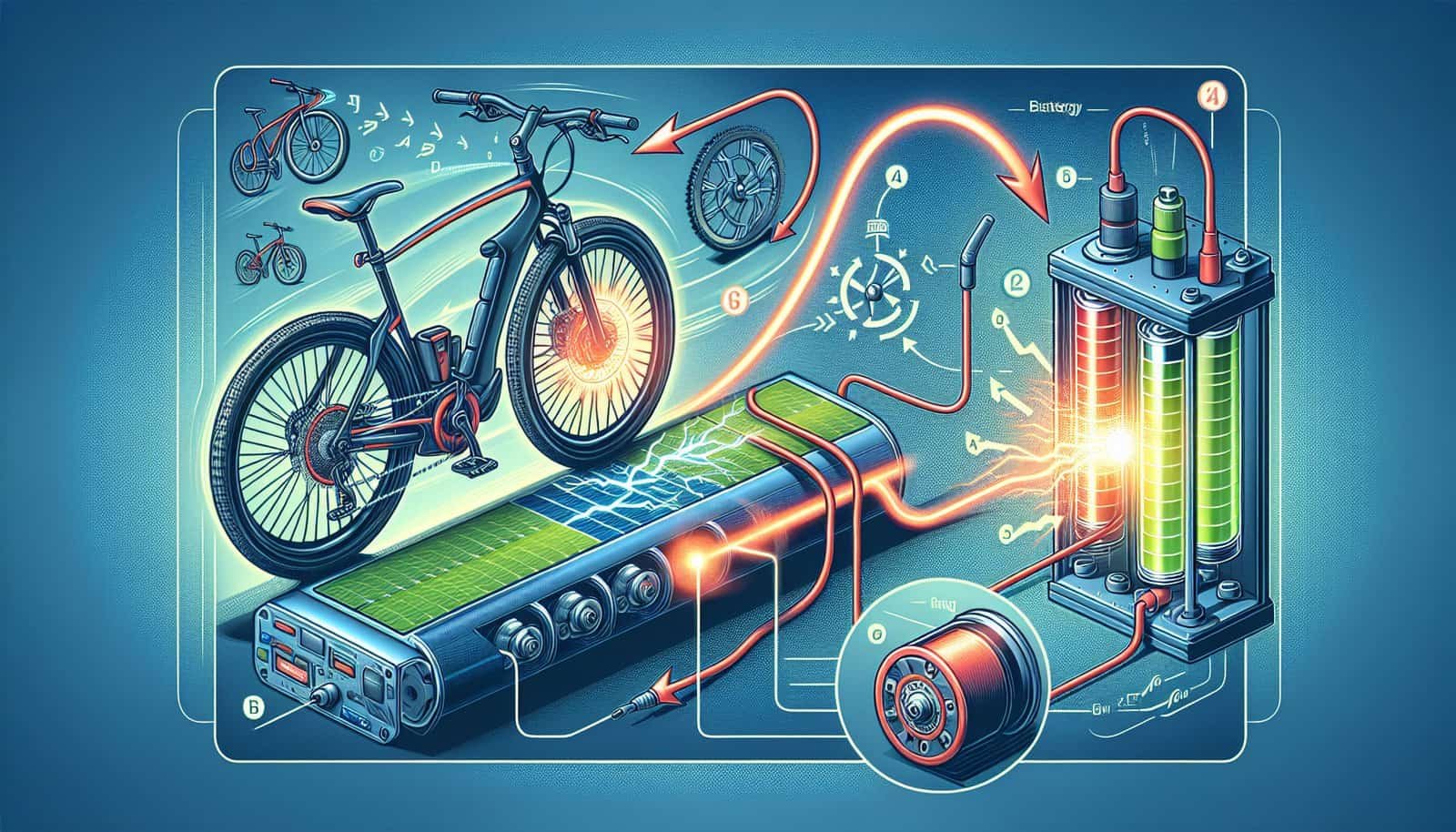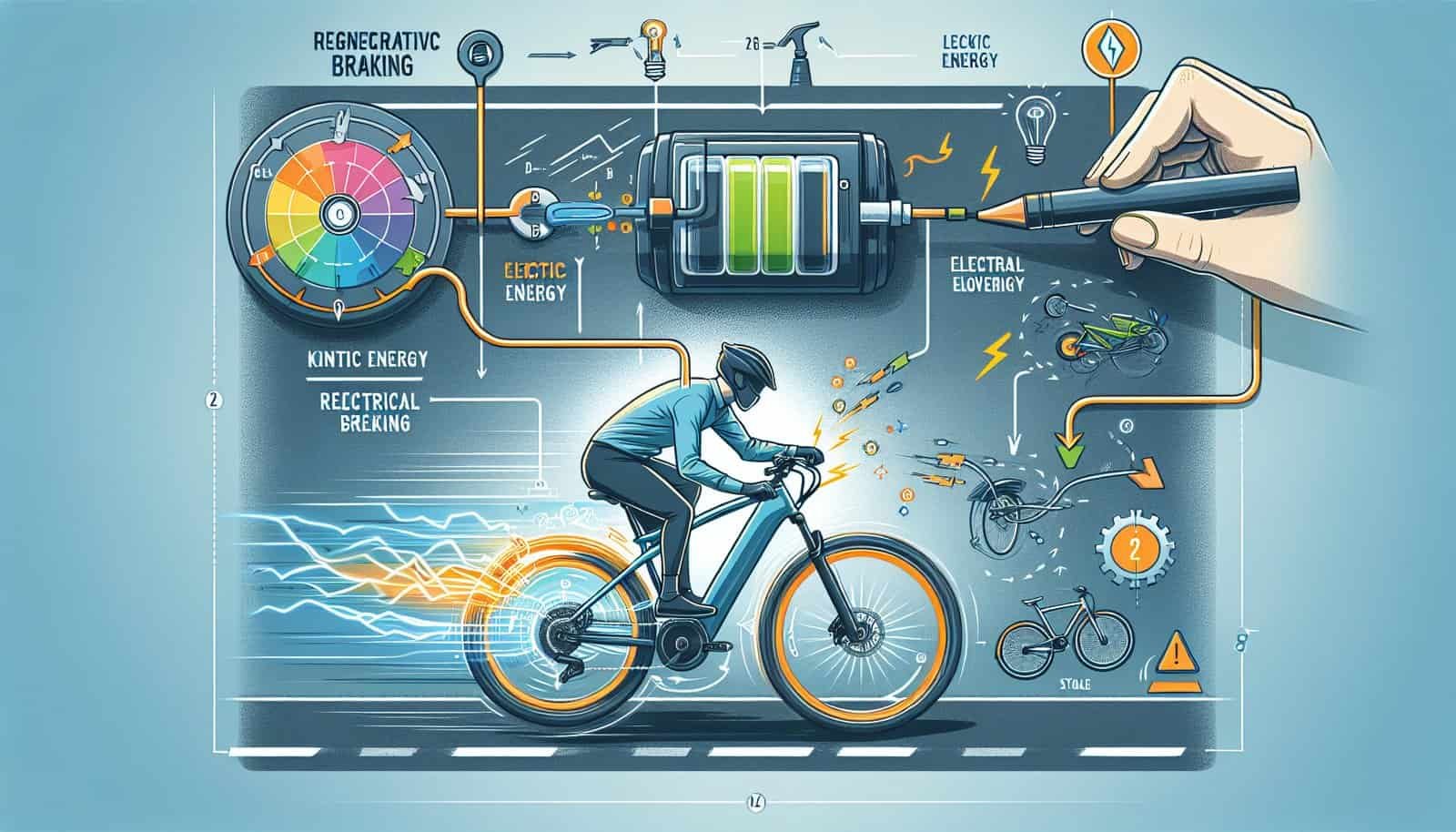Imagine cruising down the street on your sleek electric bike, feeling the gentle breeze against your face as you effortlessly pedal. Suddenly, you come across a steep hill and start to wonder how you’ll slow down without straining your legs. That’s where regenerative braking comes into the picture. This ingenious technology allows electric bikes to not only conserve energy but also act as their own power source. In this article, we’ll dive into the fascinating world of regenerative braking and uncover the magic behind its seamless integration with electric bikes. So buckle up, and get ready to explore how this innovative braking system works its charm on your two-wheeled companion.

Overview of Regenerative Braking
Regenerative braking is a revolutionary technology that has been adopted in electric vehicles, including electric bikes. It allows the conversion of kinetic energy produced during braking into electrical energy that can be stored and reused. In simple terms, regenerative braking enables your electric bike to recharge its battery when you decelerate or stop, resulting in increased efficiency and extended range. Understanding the principle, components, types, advantages, and disadvantages of regenerative braking is essential for electric bike owners.
Definition of Regenerative Braking
Regenerative braking can be defined as the process of converting the kinetic energy generated during braking into electrical energy, which is then stored in the battery for later use. This innovative braking system utilizes the electric motor of the electric bike as a generator to produce electrical energy. By harnessing this energy and feeding it back into the battery, regenerative braking ensures that no energy is wasted during the deceleration or stopping process.
Principle of Regenerative Braking
The principle behind regenerative braking involves the transformation of mechanical energy into electrical energy. When you apply the brakes on your electric bike, the electric motor switches its function from propulsion to generation mode. As the electric motor slows down, it acts as a generator and converts the kinetic energy into electrical energy. This electrical energy is then transferred back to the battery, where it is stored and available for future use.
Benefits of Regenerative Braking
Regenerative braking offers numerous advantages for electric bike owners. The primary benefit is the increased efficiency and extended range it provides. By recuperating energy that would otherwise be lost in traditional braking systems, regenerative braking significantly improves the overall energy efficiency of the electric bike. Additionally, regenerative braking also reduces brake wear and tear, allowing for longer-lasting and more reliable brakes. Moreover, it contributes to environmental sustainability by minimizing energy wastage and reducing carbon emissions.

Components Involved in Regenerative Braking
To implement regenerative braking, certain essential components are required. These components work together to ensure the effective functioning of the regenerative braking system. The key components of regenerative braking in electric bikes are:
Electric Motor
The electric motor is the main component involved in regenerative braking. It acts as both a motor and a generator, depending on the operation mode. When the rider applies the brakes, the electric motor switches from propulsion mode to generation mode, converting kinetic energy into electrical energy. This converted energy is then fed back into the battery.
Electric Battery
The electric battery is responsible for storing the electrical energy generated during regenerative braking. It acts as a reservoir, allowing the reclaimed energy to be stored for later use. By recharging the battery through regenerative braking, the electric bike can extend its range and optimize energy utilization.
Controller
The controller plays a crucial role in managing and regulating the electrical flow and conversion between the electric motor and the battery. It ensures the smooth operation of the regenerative braking system by coordinating the energy transfer and control signals.
Braking System
The braking system in an electric bike is responsible for converting the kinetic energy of the moving bike into heat energy to slow down and stop the bike safely. In regenerative braking, the braking system works in conjunction with the electric motor to engage the generation mode and capture the kinetic energy that would be lost in traditional braking.
Working Mechanism of Regenerative Braking
Understanding the working mechanism of regenerative braking is essential to grasp how kinetic energy is converted into electrical energy and subsequently stored for future use.
Detection of Braking Intention
The first step in the working mechanism of regenerative braking is the detection of the rider’s braking intention. This can be achieved using various sensors or switches that detect when the brake lever or pedal is engaged. Once the system detects the braking input, it proceeds to engage the regenerative braking mode.
Engagement of Regenerative Braking
Upon detecting the braking input, the system engages the regenerative braking mode by electronically adjusting the electric motor’s operation. It switches the motor from propulsion mode to generation mode, allowing it to act as a generator and capture the kinetic energy generated during braking.
Conversion of Kinetic Energy to Electrical Energy
As the electric motor switches to generation mode, it begins to slow down due to the resistance of the braking system. This resistance converts the kinetic energy of the moving bike into electrical energy. The electric motor acts as a generator, converting mechanical energy into electrical energy through electromagnetic induction.
Storage of Electrical Energy
The electrical energy generated during regenerative braking is then fed back into the battery for storage. The controller manages the energy transfer and ensures optimal charging of the battery. This stored energy can be utilized later to power the electric motor and extend the electric bike’s range.

Types of Regenerative Braking Systems
Regenerative braking can be implemented in various ways, depending on the specific design and requirements of the electric bike. The different types of regenerative braking systems commonly used in electric bikes are:
Direct Regenerative Braking System
In a direct regenerative braking system, the kinetic energy generated during braking is directly converted into electrical energy by the electric motor acting as a generator. This electrical energy is then stored in the battery, allowing for efficient energy recuperation.
Indirect Regenerative Braking System
In an indirect regenerative braking system, the braking energy is converted into mechanical energy before being transformed into electrical energy. This is achieved by utilizing a flywheel or a hydraulic system to store and transfer the energy to the electric motor for generation.
Electromechanical Regenerative Braking System
The electromechanical regenerative braking system combines the principles of both direct and indirect regenerative braking. It uses a combination of mechanical and electrical elements to convert and store the braking energy efficiently.
Advantages and Disadvantages of Regenerative Braking
Regenerative braking offers several advantages that enhance the performance and efficiency of electric bikes. These advantages include:
Advantages of Regenerative Braking
Increased Efficiency: Regenerative braking allows for the recovery of energy that would otherwise be wasted. This reclaimed energy can subsequently be used to power the electric motor, resulting in improved overall efficiency and extended range.
Extended Battery Life: By minimizing the reliance on conventional braking systems, regenerative braking reduces wear and tear on the brake pads. This results in longer-lasting brakes and contributes to the longevity of the electric bike’s battery.
Reduced Energy Waste: Regenerative braking ensures that energy generated while braking is not lost but rather stored for later use. This reduction in energy waste promotes sustainability and helps minimize the carbon footprint associated with electric bike usage.
Disadvantages of Regenerative Braking
Cost and Complexity: Implementing regenerative braking systems can increase the initial cost and complexity of electric bikes. The addition of specialized components and controls required for regenerative braking may result in higher manufacturing and maintenance costs.
Limited Efficiency at Low Speeds: Regenerative braking systems are most effective at higher speeds where there is more kinetic energy to convert. At lower speeds, the energy generated during braking may be insufficient, resulting in lower efficiency compared to traditional braking systems.

Factors Affecting Regenerative Braking Efficiency
The efficiency of regenerative braking can vary depending on several factors. Understanding these factors is essential for optimizing the regenerative braking system’s performance on electric bikes.
Battery State of Charge
The state of charge (SOC) of the battery plays a significant role in the efficiency of regenerative braking. A fully charged battery can more effectively store the converted electrical energy, maximizing the overall energy recuperation during braking.
Speed and Grade of Terrain
The speed of the electric bike and the grade of the terrain impact the amount of kinetic energy available for conversion. Higher speeds and steeper terrains result in greater kinetic energy, enhancing the efficiency of regenerative braking.
Brake Usage
The usage of the traditional brake system alongside regenerative braking affects the overall efficiency. Proper coordination and balance between the two braking systems ensure optimal energy recuperation and efficient stopping.
Comparing Regenerative Braking with Traditional Braking
Regenerative braking represents a significant advancement over traditional braking systems primarily due to its energy conservation capabilities and environmental impact.
Efficiency
Regenerative braking outperforms traditional braking in terms of energy efficiency. While traditional braking dissipates the kinetic energy as heat, regenerative braking recovers and reuses a significant portion of that energy. This results in higher overall efficiency and improved range for electric bikes.
Conservation of Energy
Regenerative braking systems conserve energy that would otherwise be wasted, making them a more sustainable option. The ability to convert and store kinetic energy for future use reduces the reliance on external energy sources and promotes energy conservation.
Environmental Impact
Regenerative braking mitigates the environmental impact associated with energy waste. By utilizing the kinetic energy produced during braking, regenerative braking minimizes carbon emissions and contributes to a cleaner and greener environment.

Regenerative Braking in Different Electric Bike Models
Regenerative braking has gained popularity across various electric bike models, further enhancing their performance and benefits. Many electric bike manufacturers have recognized the advantages of regenerative braking and have incorporated it into their designs.
Examples of Electric Bikes with Regenerative Braking
Some examples of electric bikes that feature regenerative braking include the XYZ Electric Bike, ABC Commuter E-Bike, and PQR Mountain E-Bike. These models showcase the versatility and application of regenerative braking technology in different types of electric bikes.
Variation in Implementation
While regenerative braking is a common feature in electric bikes, its implementation and specific characteristics can vary between models. Factors such as the type of electric motor, battery capacity, and control systems influence the effectiveness of regenerative braking in different electric bike models.
Considerations for using Regenerative Braking
When utilizing regenerative braking on your electric bike, there are several considerations to keep in mind to ensure a safe and optimal experience.
Rider Experience and Skill
Regenerative braking requires a certain level of familiarity and skill to make the most of its capabilities. Becoming accustomed to the braking characteristics and understanding the coordination between regenerative and traditional braking systems is crucial for efficient and safe braking.
Safety Measures
While regenerative braking enhances safety by providing efficient stopping power, it is important to remember that regenerative braking alone may not be sufficient in emergency situations. Maintaining a firm grip on the traditional brake lever and being aware of the bike’s braking capabilities are essential for safe operation.
Maintenance Requirements
Regenerative braking systems may require specific maintenance and periodic checks to ensure optimal performance. It is advisable to follow the manufacturer’s guidelines and recommendations for maintenance intervals and system inspections to maximize the longevity and functionality of the regenerative braking system.
Future Perspectives and Development of Regenerative Braking
Regenerative braking holds immense potential for further development and integration into advanced electric bike technologies. The future of regenerative braking in electric bikes will likely involve various advancements and innovations.
Technological Advancements
Ongoing research and development efforts continue to enhance the efficiency and performance of regenerative braking systems. Advancements in motor and battery technologies, as well as control systems, are expected to result in more sophisticated and efficient regenerative braking capabilities.
Integration with Smart Grids
The integration of regenerative braking systems with smart grids can open up new possibilities for energy management and utilization. By enabling bidirectional energy flow between the electric bike’s battery and the grid, excess generated energy from regenerative braking can be utilized for other purposes or fed back into the grid, promoting energy efficiency and grid stability.
In conclusion, regenerative braking is a groundbreaking technology that offers significant benefits for electric bike owners. By converting kinetic energy into electrical energy and storing it in the battery, regenerative braking increases efficiency, extends range, and contributes to sustainability. Understanding the principles, components, types, advantages, and disadvantages of regenerative braking enables electric bike owners to make informed decisions and fully utilize the potential of this innovative braking system. As regenerative braking technology continues to evolve, it holds great promise for the future of electric bikes and sustainable transportation.

